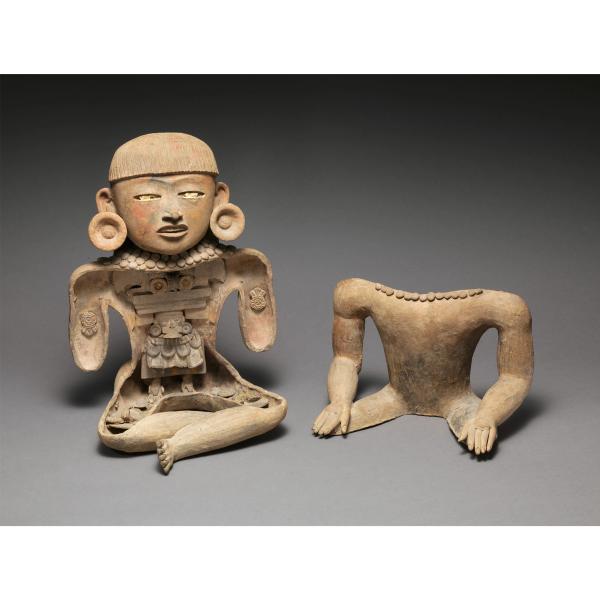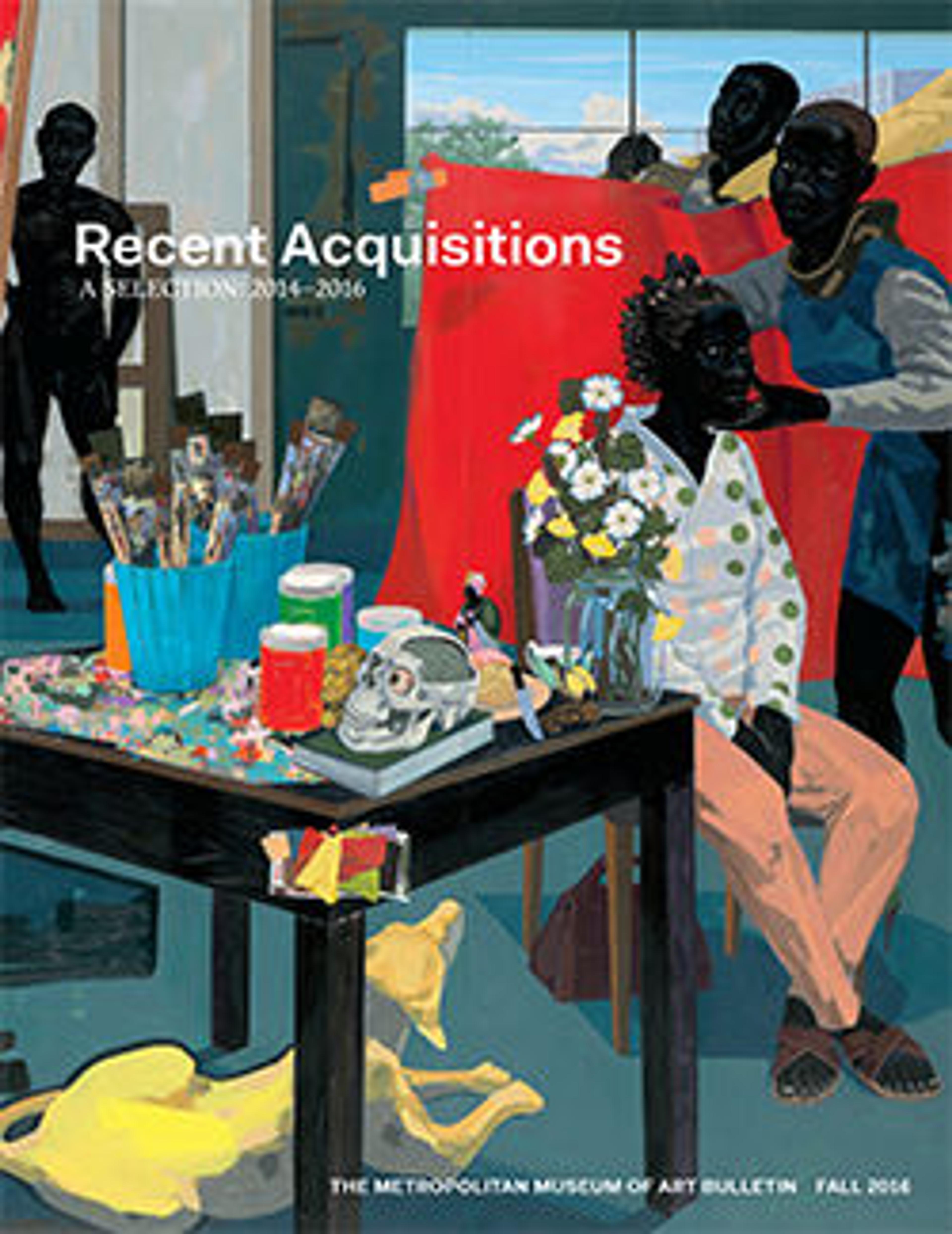Host figure
This composition comes from the Pacific Coast region of Guatemala. The style of this work, known as a "host" figure, connects it to the great Mexican city of Teotihuacan—a site nearly seven hundred miles northwest—where this type of hollow figure is thought to have originated. Host figures may have been deployed in intimate ritual activities, with the interior figurines revealed at certain moments. Such figures may speak to ancient Mesoamerican ideas of personhood and the divine, hinting at beliefs that there was an essence that resided inside humans, be they ancestors, deities, or natural forces.
Further Reading
Architectural Digest (June 1981), cover; p. 106.
Berjonneau, Gerald, Emile Deletaille, and Jean-Louis Sonnery. Rediscovered Masterpieces of Mesoamerica: Mexico-Guatemala-Honduras. Boulogne: Editions Arts 135, 1985, no. 153, p. 118.
Berrin, Kathleen, and Esther Pasztory, eds. Teotihuacan: Art from the City of the Gods. New York and San Francisco: Thames & Hudson Inc., 1993, no. 66, pp. 214–215.
Hellmuth, Nicholas M. The Escuintla Hoards: Teotihuacan Art in Guatemala. F.L.A.A.R. Progress Reports, Vol. vol. 1, no. 2. Guatemala City: Foundation for Latin American Anthropological Research, 1975, p. 58, Plate 42A-B.
LaGamma, Alisa, Joanne Pillsbury, Yaëlle Biro, and James Doyle. "Recent Acquisitions: A Selection: 2014–2016." The Metropolitan Museum of Art Bulletin (Fall 2016), p. 16.
Ferber, Andrea L., Ph.D. "Collections: The Metropolitan Museum of Art." First American Art no. 23 (Summer 2019), p. 101.
Artwork Details
- Title:Host figure
- Artist:Teotihuacan or Maya artist(s)
- Date:550–650 CE
- Geography:Guatemala, Tiquisate region, Escuintla
- Culture:Escuintla
- Medium:Ceramic, pyrite, pigment
- Dimensions:H. 14 3/4 × W. 10 3/4 × D. 10 1/4 in. (37.5 × 27.3 × 26 cm)
- Classification:Ceramics-Sculpture
- Credit Line:Partial and Promised Gift of Linda M. Lindenbaum, from the Collection of Samuel H. and Linda M. Lindenbaum, 2015
- Object Number:2015.226a, b
- Curatorial Department: The Michael C. Rockefeller Wing
Audio

1633. Figura anfitriona, artista(s) teotihuacano(s) o maya(s)
David Carballo y Oswaldo Chinchilla
DAVID CARBALLO: Estamos viendo una figura muy interesante y muy simbólica que se llama Figura huecas o de huésped y huésped, porque adentro vienen otras figuras. Entonces tenemos un figura de mayor tamaño donde se puede apreciar sus rasgos más naturalistas. Y adentro hay figuras que están mucho más elaboradas. En su revestimiento… tienen tocados y trajes de alto nivel social.
Hola, me llamo David Carballo. Soy profesor de Antropología, Arqueología y Estudios Latinoamericanos en Boston University.
JOSÉ MARÍA YAZPIK (NARRADOR): Esta compleja escultura muestra a un joven sentado. La parte frontal del cuerpo está diseñada para ser retirada como la tapa de una caja. Mire de cerca la figura hueca: justo debajo del cuello verá dos delicados círculos, que representan los ojos de una mariposa. Estas efigies conocidas como figuras huésped y las representaciones de mariposas son típicas de la gran metrópoli de Teotihuacan, una de las ciudades más grandes del mundo en el primer milenio de nuestra era.
DAVID CARBALLO: Y las mariposas tienen estas en el arte de Teotihuacan, ojos exagerados y el probisco que tienen las mariposas, eso se ve encima. Las mariposas dentro del centro de México tienen una representación metafórica de un Paradiso. Un Paradiso del extra mundo para que los que fallezcan haciendo algo noble como fallecer en el campo de batalla o para las mujeres falleciendo, dando a luz.
JOSÉ MARÍA YAZPIK: Se desconoce cómo se utilizaron las figuras huésped o su significado. Las pequeñas figuras dentro de la figura principal podrían representar valor, liderazgo, o el poder de Teotihuacan. También podrían ser ancestros o divinidades. Oswaldo Chinchilla, arqueólogo y profesor de antropología, Yale University.
OSWALDO CHINCHILLA: En Teotihuacan hay un interés en representar el cuerpo humano como un repositorio dentro del cual puede haber otros seres. Y en este caso más bien todo el cuerpo funciona como un abrigo dentro del cual hay otras figuras. Es posible que estas figuras se concibieran como representaciones corporales de templos, como una persona hecha templo. Dentro del cual residen estas otras figuras, estos otros personajes que nuevamente quizás puedan ser los ancestros deificados o representaciones de dioses.
JOSÉ MARÍA YAZPIK: Si bien la figura huésped sigue el estilo teotihuacano, esta pieza fue encontrada lejos de esa gran ciudad.
DAVID CARBALLO: Viene de la región de Escuintla, en la costa pacífica de Guatemala. Entonces a casi mil Km de la ciudad. Tenemos ejemplos de este tipo de arte. Y fue representante de la ciudad en largas distancias.
More Artwork
Research Resources
The Met provides unparalleled resources for research and welcomes an international community of students and scholars. The Met's Open Access API is where creators and researchers can connect to the The Met collection. Open Access data and public domain images are available for unrestricted commercial and noncommercial use without permission or fee.
To request images under copyright and other restrictions, please use this Image Request form.
Feedback
We continue to research and examine historical and cultural context for objects in The Met collection. If you have comments or questions about this object record, please contact us using the form below. The Museum looks forward to receiving your comments.
